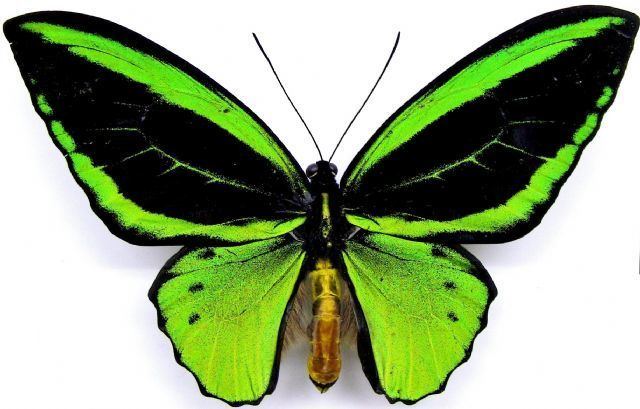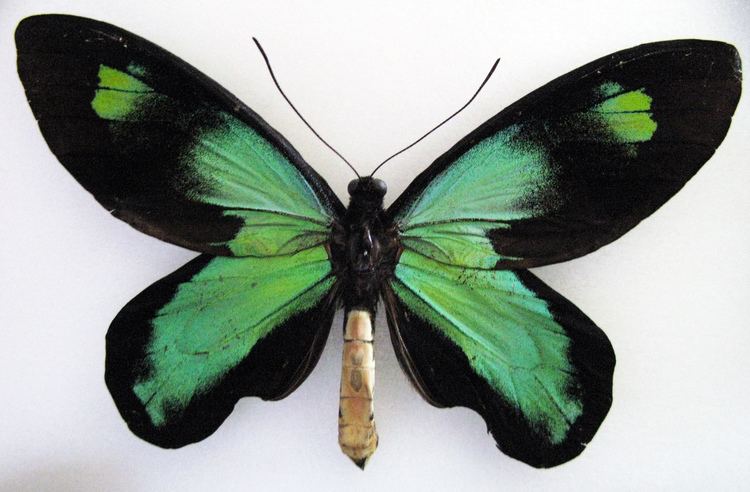Family Papilionidae | ||
 | ||
Representative species | ||
Birdwings are butterflies in the swallowtail family, that belong to the genera Trogonoptera, Troides, and Ornithoptera. Most recent authorities recognise 36 species, however, this is debated, and some authorities include additional genera. Birdwings are named for their exceptional size, angular wings, and birdlike flight. They are native to the Indian subcontinent, mainland and archipelagic Southeast Asia, and Australasia.
Contents

Included among the birdwings are some of the largest butterflies in the world: the largest, Queen Alexandra's birdwing; the second largest, the Goliath birdwing; the largest butterfly endemic to Australia, the Cairns birdwing; and the largest butterfly in India, the southern birdwing. Another well-known species is Rajah Brooke's birdwing, a particularly attractive species named after Sir James Brooke, the first White Rajah of 19th-century Sarawak.

Due to their size and brightly coloured males, they are popular among collectors of butterflies, but all birdwings are now listed by CITES, thereby limiting (and in the case of O. alexandrae completely banning) international trade.
Natural hybrids

Ova

After mating, females immediately begin to seek appropriate host plants; climbing vines of the genera Aristolochia and Pararistolochia (both in the family Aristolochiaceae) are sought exclusively. The female lays her spherical eggs under the tips of the vine's leaves, one egg per leaf.
Larva
The caterpillars are voracious eaters but move very little; a small group will defoliate an entire vine. If starved due to overcrowding, the caterpillars may resort to cannibalism. Fleshy spine-like tubercles line the caterpillars' backs, and their bodies are dark red to brown and velvety black. Some species have tubercles of contrasting colours, often red, or pale "saddle" markings. Like other members of their family, birdwing caterpillars possess a retractable organ behind their heads called an osmeterium. Shaped like the forked tongue of a snake, the osmeterium excretes a fetid terpene-based compound and is deployed when the caterpillar is provoked. The caterpillars are also unappealing to most predators due to their toxicity: the vines which the caterpillars feed upon contain aristolochic acid, a poisonous compound known to be carcinogenic in rats. The feeding caterpillars incorporate and concentrate the aristolochic acid into their tissues, where the poison will persist through metamorphosis and into adulthood.
Pupa
Birdwing chrysalids are camouflaged to look like a dead leaf or twig. Before pupating, the caterpillars may wander considerable distances from their host plants. In O. alexandrae, it takes about four months to get from egg to adult. Barring predation, this species can also survive up to three months as an adult.
Imago
Birdwings inhabit rainforests and adults are usually glimpsed along the forest periphery. They feed upon—and are important long-range pollinators of—nectar-bearing flowers of the forest canopy, as well as terrestrial flowers, such as lantana. They are strong flyers and seek sunlit spots in which to bask.
Breeding behaviour varies little between species; the female's role is relatively passive, slowly fluttering from perch to perch while the male performs an elaborate, quivering yet stationary dance 20–50 cm above her.
Birdwings are typified by large size (up to a maximum body length of 7.6 cm or 3 inches and a wingspan of 28 cm or 11 inches in O. alexandrae), showy colouration (in contrasting shades of green, yellow, black, white, and sometimes blue or orange), and slender, lanceolate forewings. With few exceptions (i.e., the New Guinean O. meridionalis and O. paradisea), the hindwings lack tails. Sexual dimorphism is strong in Ornithoptera species only, where males are black combined with bright iridescent green, blue, orange, or yellow while the larger and less colourful females are overall black or dark brownish with white, pale brown, or yellow markings.
Males and females of most Troides birdwings are similar and have jet black to brown dorsal forewings, often with the veins bordered in grey to creamy white. At least one of these darkly-coloured species (T. rhadamantus) possesses thermoreceptors on the anal veins (A2 and A3) of the wings and on the antennal clubs. The antennal receptors of the clubs—which also possess hygroreceptors that measure atmospheric humidity—are known as sensilla basiconica. The thermoreceptors are sensitive to sudden increases in temperature; they are thought to help the butterfly thermoregulate and avoid overheating while basking.
The colours of most species are pigmentary (via papiliochrome); but two species, Troides magellanus and the much rarer T. prattorum, are noted for their use of limited-view iridescence: the yellow of the dorsal hindwings is modified by bright blue-green iridescence which is only seen when the butterfly is viewed at a narrow, oblique angle. This "grazing iridescence" is brought about through diffraction of light (after back-reflection) by the wings' extremely steeply-set, multilayered rib-like scales (rather than the ridge-lamellae of most other iridescent butterflies, such as Morpho species). Such limited-view iridescence was previously only known from one other species, the riodinid Ancyluris meliboeus. In A. meliboeus, however, the iridescence is produced by ridge-lamellar scales and features a wider range of colours.
The close evolutionary relationship between Troides and Ornithoptera butterflies is well demonstrated by the fact that commercial breeders have produced numerous hybrids between the two.
The final and smallest genus is Trogonoptera with just two species. They resemble each other, being overall black with iridescent green markings and a red head. Females are duller than males.
Distribution
Birdwings are generally found from Southeast Asia to northern Australasia. Trogonoptera brookiana inhabits the Thai-Malay Peninsula, Borneo, Natuna, Sumatra, and various surrounding islands. Trogonoptera trojana is endemic to Palawan in the Philippines. Troides species are distributed widely across the Indomalaya ecozone, but may be found as far east as New Guinea in the case of Troides oblongomaculatus. Some species may be found as far west as India, and are the westernmost distributed of all birdwings. All Ornithoptera species are found in the northern portion of the Australasian ecozone, east of Weber's line; the Moluccas, New Guinea, the Solomon Islands, and northeastern Australia. An outlier is Ornithoptera richmondia, which may be found in far northeastern New South Wales, Australia in the southernmost area of its range; the southernmost distribution of all birdwings.
Status and protection
With the exception of Queen Alexandra's birdwing (O. alexandrae), all birdwings are listed in Appendix II of CITES, and accordingly their trade is restricted in countries that have signed the CITES convention. Exceptions are made for captive-reared specimens, which mainly originate from ranches in Papua New Guinea and Indonesia. Most species of all three genera have now been reared in captivity, though with significant differences in the quantities reared of each species. O. alexandrae is listed on Appendix I and therefore cannot legally be traded internationally. At the 2006 meeting of the CITES Animals Committee some suggested O. alexandrae should be moved to Appendix II, as the conservation benefits of sustainable management perhaps are higher than those of the trade ban.
Three Troides and eight Ornithoptera species have been given assessments by the IUCN Red List, with classifications ranging from "least concern" to "endangered".
Richmond birdwings (O. richmondia) depend on the plant Aristolochia praevenosa which they need for their caterpillars. However, the very similar Aristolochia elegans (Dutchman's pipe) which can be found in many Australian backyards, kills the caterpillars.
